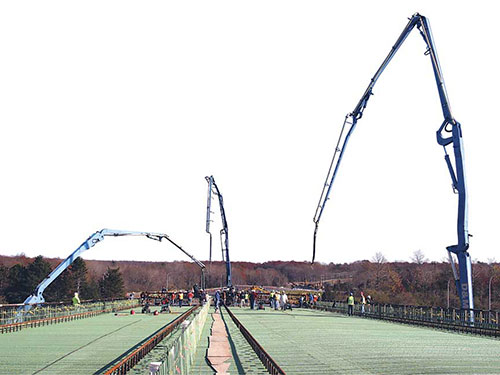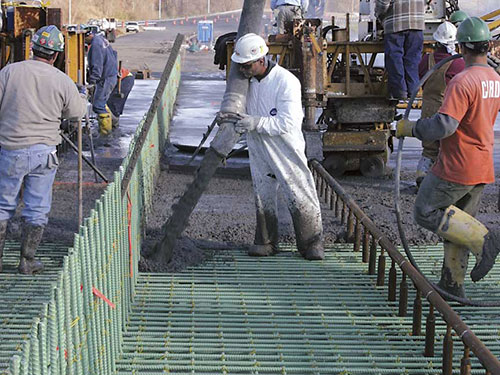GOMACO World Index --- GOMACO World 34.2 - October 2006
#11 Of 17 Different Decks On Route 403
Two C-450s work side by side on one of 17 different bridge decks along the new Route 403 in Rhode Island.
The Rhode Island Economic Development Corporation is in the process of turning 8000 acres of an old naval base into the new Quonset Point Industrial Park in North Kingston, Rhode Island. The park is already home to the East Coast’s largest port where ships and car carriers unload.
The state needed a new highway system to transport the goods and the people from the port into North Kingston and the rest of Rhode Island. The answer was the relocation of Route 403 and building 4.5 miles (7.2 km) of new four-lane, limited access highway stretching from Route 4 in East Greenwich to the Industrial Park.
Cardi Corporation Inc., based out Warwick, Rhode Island, is the contractor in charge of the 17 different bridge decks on the project. Their bridge deck finisher of choice is the GOMACO C-450.
They recently just finished their 11th bridge deck on Route 403, and each deck has had its challenges. One deck had to be finished on a radius while running uphill on a 6.6 percent incline. The deck was 350 feet (106.7 m) long, 60 feet (18.3 m) wide, and built over two different types of beams - steel I-beams and precast box beams. The bridge crosses an Amtrak railway and Amtrak specifications require box beams in the portion of the bridge crossing over their tracks. Because of the two different types of beams, the depth of the deck varied between 5.5 inches (140 mm) up to 20 inches (508 mm). The deck also had to be finished on a 60 foot (18.3 m) skew.
It had to be poured using two C-450s. The deck had pre-existing steel in it for a median barrier that Cardi had to work around. They set up one C-450 to finish 40 feet (12.2 m) wide for two lanes on the bridge and another to finish the third lane at 20 feet (6.1 m) wide. Striker plates or L-brackets attached to the C-450s help finish the median area and two workers apply a final hand-finish to that portion of the deck.
“The easiest part of a deck like this is pouring it,” Alfred Nazareth, project manager for Cardi, said. “The hardest part is making sure the set up is right and the profile is where it needs to be.”
Accurate rail set up is crucial for a deck with this many challenges. For Nazareth and his crew, the process of setting the rails isn’t just a company secret, it’s a division secret, and one they carefully protect. It’s a process that takes some serious analyzing.
“It’s just not a simple thing of a little formula or anything like that,” Nazareth explained. “Rails have to be set to grade, you have to know the cross section of the bridge at the beginning, how it varies throughout the pour, and where to set the power transition adjuster (PTA). Then you have to do trial runs and make sure you’ll have the appropriate amount of concrete in all areas so you’ll be able to produce the cross section that it’s designed for before you do the pour.
“You have to analyze how you’re going to start the C-450, what the cross section looks like, what the cross section is doing during the movement of the machine, how it’s going to end up, and everything you have to do in between to achieve all that.”
With set up complete and a successful dry run accomplished, Cardi calls in their crew and prepares for the actual pour. They prefer to pour their decks later in the afternoon. A late afternoon pour guarantees that more workers are available, consistent concrete delivery, and cooler temperatures.
The concrete mix design is a high-performance 5000 pound (35 mPa) concrete with several different additives. Retarder in the mix is a key ingredient.
“We use retarder in almost all of our pours,” Nazareth said. “We don’t have to, but we do. This particular concrete turns very, very fast so we go with the extra money and use the retarder to give us a little more time.”
Slump is kept as high as possible, averaging up to five inches (127 mm).
“The wetter it is, the better,” Nazareth said. “Coming off the hose we like it to have a four or five inch (102 to 127 mm) slump minimum. Definitely the wetter it is, the better and we get higher strengths from the concrete.”
Production with the C-450, with two pumps placing concrete, averages between 100 to 120 cubic yards (76.5 to 91.7 m3) per hour. Cardi’s two C-450s may be the older style, but they’re still working well for the company. In just over 10 hours time, the deck on this eleventh bridge was finished.
“We like the simplicity of our C-450s,” Eric Hammerschlag, field engineer for Cardi, said. “We like the double drum with reverse augers and how the carriage, when it hits the opposite end of the finishing pass, will stop, rotate for the next angle, and then start moving ahead again. That’s a great thing.”
Very little finishing work is done behind the C-450s. The new deck is bull floated and finishers on each side of the machine clean up the edges around the rails. A seven-day curing process is started immediately. The deck is misted right behind the finisher and two workers stay throughout the night to continue the misting process. The next morning, the full crew returns and weeper hoses are put on and the deck is covered with either plastic or burlene.
With this bridge deck pour complete, it’s time for Cardi to set their sites on the next one. They still have six decks to complete on their Route 403 project.
“Pouring is the fun part of any bridge project,” Nazareth said. “It’s the week or two before the pour that are crazy. Your set up has to be right on if you’re going to be successful. Once everything is set to the right grade, the best thing to do is stand back and look at the rails from a distance. If you see waves in the rails, you’re going to have waves in the deck when you’re done. Take the time to do the extra tweaking, make it pleasing to the eye and you won’t have a problem. It’s as simple as that.”
Subscribe to Receive GOMACO World Magazine

